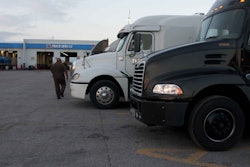
Those in the industry scratching their heads over turnover often find themselves asking the question in the headline here. Those who promote the notion of a “driver shortage” routinely bump the projected numbers. Questions persist: how do we attract the next generation? Why do the drivers we have leave?
Many are quick to say it is a driver-pay problem.
For me, after 16 years, 12 of them over the road, I was simply burned out. I was sick and tired of being taken advantage of. Excessive tolls, market gate fees, lumper fees often not reimbursed as they should have been. Not getting paid for detention time or other delays that were no fault of my own. Add to that lack of parking and company micromanagement, once you finally got your check with taxes and health coverage taken out, along with the cost of living on the road, as a company driver it became tougher and harder to justify being on the road with little ones growing up and needing a father’s influence.
I might have made as much money flipping hamburgers at McDonald’s.
I tried local, but honestly never felt more tired and unsafe in my life. The hours I was pushed to do, coupled with the physical demand, far outweighed anything I had ever done running over the road. While the money was decent, I could not enjoy my time at home, because I was either sleeping or a walking zombie.

Finally, I called it quits and spent five years elsewhere in trucking (teaching, part-time local delivery) and logistics, some just jockeying trailers for a major leather manufacturer. It was in going back to school that I discovered a calling – in psychology research and counseling. I was surprised to find out it led me right back into trucking, while pursuing those goals.
While I was off the road working on my undergrad degree, often the curious young men and women in my classes would ask me what trucking was like. Inevitably came the question: How much does it pay?
They were under the impression it paid well.
Imagine their surprise when I explained that by the time I paid to live on the road, my average annual pay amounted to about $38,000 as a company driver; while I do better now as an owner-operator, I have however taken on a great deal more risk.
After many conversations with these young men and women, I think I can safely say that, unless there’s a bona fide likelihood of making $100,000 or so a year in trucking, these kids are not going to waste their time. They are simply not interested. They’re not stupid. They look at the average cost of a home, the average cost of a new car, and so much more — they know that if they do not want to be in debt for the rest of their lives, they need an income to match.
As has been unfortunately underscored by recent reports involving the Bureau of Labor Statistics economist who noted no real “shortage” of truckers, market dynamics dictate much of the tinkering that goes on from this company to that when it comes to driver pay. If we want pay to rise substantially, rates paid to trucking companies need also to rise. Drivers and truckers don’t have a lot of control over how much stuff needs to be moved in the country, but we do have some control over capacity. Limit capacity, and we force the market to raise rates to meet demand. We saw this soon, and briefly, after the mandatory implementation of ELDs.
While I dislike the notion of new regulations as a general rule, we may need our government’s help here. Since trucking companies cannot seem to grasp this concept, seen in the recent high-rate environment with their rush to order more trucks and trailers in a bid for growth instead of adjusting existing capacity and logistical abilities. Often rapid growth, as opposed to the slow-and-steady variety, is not always best.
Excepting the cases of those trucking companies fulfilling the demands of a contract, it may have been wiser to allow the industry to operationally correct itself as ELDs were being implemented. But as we have seen, the market was quickly flooded with big truck orders from established companies, start-ups also coming online in droves, increasing capacity and driving spot market rates down after the big run-up.
Now that those rates have come back down to earth, many start-ups are folding and more established owner-ops, small fleets and larger companies are picking up the slack, yet rates are not responding.
What if we could get the FMCSA to change the HOS to allow drivers to only drive 8.5 hours a day. (And let’s face it, if we truly cared about safety, that is exactly what we’d do.) This would require seriously addressing the parking issue, and perhaps an amendment to the Fair Labor Standards Act (FLSA) to force the issue of compensation for time worked.
Yes, I know for most drivers this sounds counterintuitive. And I am sure many of you disagree, and many companies would fight any such attempt because this would allow drivers to slow down, place more value on time, and require overtime pay for any time over 40 hours (see the FLSA mentioned above, which has long exempted interstate drivers from the requirement). Yet slowing down drivers would improve safety performance without risking the safety of those operators by implementing speed limiters.
A change like this would of course impact owner-operators with new limitations, I know. But as an owner-operator who only drives 8.5 hours a day, I have actually seen an increase in miles, having already logged about 140,000 miles to date for this year (at 70-75 typical speed, and I’ve spent much of the year working).
Still, until drivers, companies, and the powers that be come to some sort of agreement, drivers’ time will continue to be devalued. Companies will persist in leaving drivers swinging in the wind when it comes time to tell that shipper to get a move on or pay up, or when it comes time to pay them what they’re really worth.












